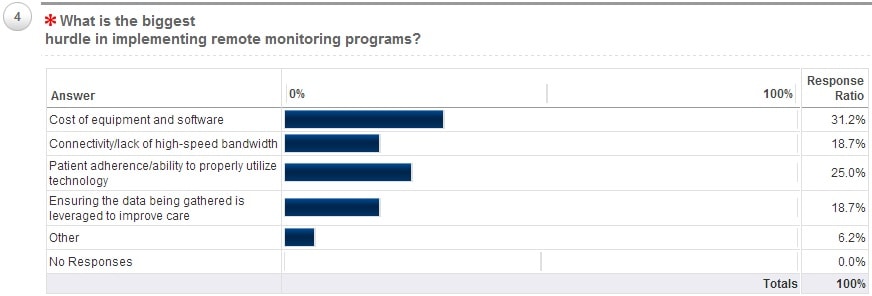
Remote Monitoring Is On The CIO’s Radar, But Not Alone
Despite numerous reports citing mounting interest in remote monitoring programs, for most CIOs, the technology is still a “nice to have” and not a “must have,” according to the February healthsystemCIO.com Snap Survey. While remote monitoring is certainly gaining traction, it will continue to take a backseat to other pressing priorities, the survey found — at least until more evidence of cost savings becomes available.
Of the CIOs who responded, 38 percent said they currently have a remote monitoring program in place. Among those who answered ‘no,’ 44 percent said they hope to implement one in the next year, while 13 percent consider it to be an immediate priority. For a quarter of respondents, however, there are no plans to add another major IT task to their already lengthy lists — particularly one that requires a significant upfront investment.
“The industry needs a few good demonstration cases before we see widespread adoption,” one CIO noted.
Not surprisingly, cost of equipment/software was cited as the biggest hurdle (31 percent), followed by a patient’s ability to properly utilize the technology (25 percent). Other factors included connectivity issues, data utilization concerns, and a lack of integration with existing EMR systems.
When it comes to determining whether the potential savings from remote monitoring programs outweigh the costs, CIOs were divided, with 56 percent saying yes and 43 percent answering no.
“There is so much pressure on revenue at this point that funding for discretionary projects is nonexistent,” said one respondent. “Since early industry case studies did not demonstrate improved health or cost reduction, the investment does not seem justified.”
(SnapSurveys are answered by the healthsystemCIO.com CIO Advisory Panel. To go directly to a full-size version of any individual chart, click on that chart.)
1. Does your organization currently have a remote monitoring program in place?
Yes
- It’s limited to stroke for now.
No
2. If not, is it on your radar?
Yes, it is an immediate priority
Yes, we hope to implement in the next year
- Our goal is to begin this process in the next fiscal year.
Not at this time
- We are exploring various telemedicine options and have not crystallized our strategy as yet.
N/A
3. If you answered ‘yes’ to question #1, do you feel it has had a positive impact on patient care?
Yes
No
Too soon to tell
4. What is the biggest hurdle in implementing remote monitoring programs?
Cost of equipment and software
- And the ability for people to use it.
- There is so much pressure on revenue at this point that funding for discretionary projects is nonexistent. Since early industry case studies did not demonstrate improved health or cost reduction, the investment does not seem justified.
Connectivity/lack of high-speed bandwidth
Patient adherence/ability to properly utilize technology
Ensuring the data being gathered is being leveraged to improve care
Other
- Lack of tight integration with existing EMR.
5. Do you believe the potential savings resulting from remote monitoring programs justify the upfront costs?
Yes
- At least that is why we invested in them. Only time will really tell. We are only 60 days into it.
No
- The benefit is better care and lower costs.
- Not yet, but soon.
Not sure yet.
- It is really hard to tell at this point. I would hope it would decrease readmissions or office visits, which would be a potential savings.
- It still remains to be seen. The industry needs a few good demonstration cases before we see widespread adoption.







Share Your Thoughts
You must be logged in to post a comment.